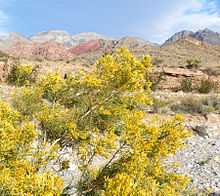Ericameria paniculata
| Ericameria paniculata | |
|---|---|
 | |
| Conservation status | |
| Scientific classification | |
| Kingdom: | Plantae |
| (unranked): | Angiosperms |
| (unranked): | Eudicots |
| (unranked): | Asterids |
| Order: | Asterales |
| Family: | Asteraceae |
| Genus: | Ericameria |
| Species: | E. paniculata |
| Binomial name | |
| Ericameria paniculata (A.Gray) Rydb. | |
| Synonyms | |
|
Chrysothamnus paniculatus | |
Ericameria paniculata (syn. Chrysothamnus paniculatus) is a species of flowering plant in the aster family known by the common names desert rabbitbrush, Mojave rabbitbrush, catclaw rabbitbrush, black-banded rabbitbrush, sticky rabbitbrush, and punctate rabbitbrush. It is native to the deserts of the southwestern United States.[1]
This plant is a branching shrub reaching up to 2 meters tall. The spreading or erect stems are glandular and resinous and are often banded or splotched with black from a fungus. The glandular leaves are up to 3 or 3.5 centimeters in length. The inflorescence is an array of flower heads, each of which contains 5 to 8 disc florets and no ray florets. The fruit is up to a centimeter long including its long pappus. They are wind-dispersed.[1][2][3]
This plant is found in a great variety of habitats, including disturbed areas such as roadsides. It tolerates poor soils. It may be found alongside creosote, Joshua tree, baccharis, white burrobush, desert saltbush, and catclaw acacia.[1]
| Wikimedia Commons has media related to Ericameria paniculata. |
References
- ↑ 1.0 1.1 1.2 Tesky, Julie L. 1993. Chrysothamnus paniculatus. In: Fire Effects Information System, [Online]. U.S. Department of Agriculture, Forest Service, Rocky Mountain Research Station, Fire Sciences Laboratory.
- ↑ Ericameria paniculata. Flora of North America.
- ↑ Chrysothamnus paniculatus. Jepson Manual Treatment.
